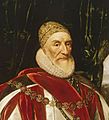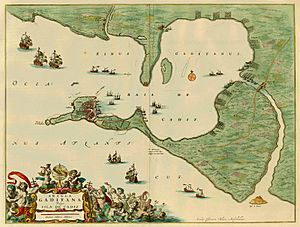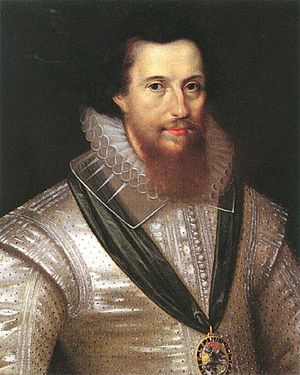Capture of Cádiz facts for kids
Quick facts for kids Capture of Cádiz |
|||||||
|---|---|---|---|---|---|---|---|
| Part of the Anglo–Spanish War (1585) | |||||||
 The English storm the city |
|||||||
|
|||||||
| Belligerents | |||||||
| Commanders and leaders | |||||||
| Strength | |||||||
| 40 ships and 5,000 men | 150 ships and 14,000 men | ||||||
| Casualties and losses | |||||||
| 32 ships scuttled or sunk | 3 galleons sunk or burnt, 2 other ships sunk, 5 other ships captured, ~2,000 killed |
||||||
The Capture of Cádiz in 1596 was a big event during the Anglo-Spanish War. English and Dutch forces attacked the Spanish city of Cádiz. This attack was led by Robert Devereux, 2nd Earl of Essex and Charles Howard, 1st Earl of Nottingham.
The Spanish leaders were not ready for the attack. So, the English and Dutch forces faced little resistance. To stop the attackers from taking their ships, the Spanish set their own fleet on fire. The attacking forces then landed, took over the city, looted it, and burned it down.
They also took important citizens as hostages. These hostages were taken to England and held for ransom. The attack caused huge economic losses for Spain. The city and its fleet were destroyed. This was one of the biggest English victories in the war.
Contents
Why the Attack Happened
On June 13, 1596, a large fleet sailed from Plymouth, England. This fleet had about 150 English and Dutch ships. Seventeen of these ships belonged to the Royal Navy. There were over 6,000 soldiers and nearly 7,000 sailors.
Charles Howard, 1st Earl of Nottingham, was the main admiral for the fleet. The soldiers who would land were led by Robert Devereux, 2nd Earl of Essex. Other important leaders included Lord Thomas Howard, Sir Walter Raleigh, and Sir Francis Vere.
Queen Elizabeth I of England also had a representative, Anthony Ashley, on board. About 20 more ships from the United Provinces joined them. These ships carried 2,000 men and were led by Admiral John de Duyvenvoorde.
The city of Cádiz was very important to Spain. It had about 6,000 people living there. It was one of Spain's main ports and where the Spanish treasure fleet left for the Americas.
The Capture of Cádiz
|
|
On June 29, news reached Cádiz that an English fleet was nearby. At that time, about 40 Spanish ships were in the Bay of Cádiz. There were also 16 other ships ready to sail to the West Indies. These unarmed ships quickly fled to Puerto Real for safety.
Spanish commanders Juan Portocarrero and Alonso de Bazán tried to stop the Anglo-Dutch fleet. They wanted to prevent them from entering the bay.
On June 30, at 2 AM, the Anglo-Dutch fleet was seen from Cádiz. Bad weather made it hard for them to enter the bay. At 5 AM, a fierce fight with cannons began. After two hours, the Spanish fleet had to retreat further into the bay.
During the fight, two Spanish galleons, San Andrés and San Mateo, were captured. Two others, San Felipe and Santo Tomás, were set on fire by their own captains to stop them from being captured. The Anglo-Dutch fleet entered the bay by 8 AM.
By midday, more Spanish soldiers arrived in Cádiz. They came from nearby towns like Vejer de la Frontera and Jerez. These soldiers were new and not well-armed. About 5,000 more men joined them from other forts.
At 2 PM, about 200 English soldiers landed at El Puntal. They attacked the Spanish defenders. The Spanish forces were disorganized and had no clear leader. Before 5 PM, the English easily took control of the city. Another part of the army moved towards Point Zuazo.
In the fights outside the city, both sides lost about 25 men. The fort of San Felipe gave up the next day. The Spanish defense was weak because their cannons were old, they had little ammunition, and their leaders were disorganized.
Looting the City
Once inside Cádiz, the English and Dutch soldiers began to loot the city. Churches and homes were robbed. However, the soldiers treated the people well, especially the women. One observer, Lope de Valenzuela, wrote that they did not harm the people.
Before the English could capture the Spanish fleet hiding in Puerto Real, the Duke of Medina-Sidonia ordered it to be destroyed. Thirty-two ships, including the treasure fleet vessels, were burned.
On July 3, the city's leaders made a deal with the English. The people of Cádiz could leave if they paid a ransom of 120,000 ducats. The English also demanded the release of 51 English prisoners. The citizens of Cádiz left the city with only what they could carry.
To make sure the ransom was paid, several important citizens were kept as hostages. These included the head of the trade house, the mayor, and religious leaders.
The Earl of Essex wanted to keep Cádiz as a base for England and the Dutch. But Admiral Howard and other English officers disagreed. They thought it was too risky and against the Queen's orders. So, the plan to occupy the city was stopped.
On July 14, the English burned Cádiz. The next day, they left the bay. They took the hostages with them because the Spanish could not pay the ransom.
Journey Back Home
On their way back to England, the fleet stopped and burned Faro, Portugal. The soldiers also took books from the Bishop of Lisbon's library. These books were later given to the Bodleian Library at the University of Oxford by the Earl of Essex.
Near Lisbon, they heard that the Spanish treasure fleet was coming to the Azores. The Earl of Essex wanted to capture it, but Admiral Howard said it was against their orders. So, the fleet continued its journey and arrived in Plymouth a few days later.
After the Attack
The attack on Cádiz in 1596 was one of Spain's worst defeats in the war. The financial losses were huge, estimated at 5 million ducats. This contributed to Spain's government running out of money that same year.
However, Spain quickly rebuilt its navy. In October 1596, a new fleet, known as the 2nd Spanish Armada, sailed towards England. But a big storm in the Bay of Biscay caused heavy losses, and the fleet had to return. Spain's king, Philip II, still wanted revenge. So, in September the next year, a rushed 3rd Spanish Armada sailed. Again, a storm near the English coast scattered the fleet.
The city of Cádiz was left in ruins. Many churches, hospitals, and 290 out of 1,303 houses were burned. After the English and Dutch left, Spanish leaders thought about building new defenses or moving the city. They decided to rebuild the defenses, and construction started in 1598. King Philip II also gave the city a ten-year break from paying taxes.
The hostages were not freed until July 1603, after Queen Elizabeth I died. The next year, Spain and England signed the Treaty of London (1604), ending the war. However, the English tried to attack Cádiz again in 1625, but that attempt failed.
Interesting Facts
- The story of the 1596 attack was written by English historian Richard Hakluyt. However, Queen Elizabeth I of England ordered it to be removed from early books. This was likely because of problems between the Queen and the Earl of Essex.
- During the attack, English soldiers took a lot of sherry wine from Cádiz. This helped make sherry popular in England. Some people even joked that the soldiers attacked just to get the wine!
- The famous writer Miguel de Cervantes wrote a funny poem about the Spanish troops who arrived in Cádiz after the English left.
- It is said that the Earl of Essex bravely climbed the walls of Cádiz all by himself during the battle.
- Thomas Gates, who later became governor of Jamestown, was made a knight for his bravery during the battle.
Images for kids
See also
 In Spanish: Toma de Cádiz para niños
In Spanish: Toma de Cádiz para niños








